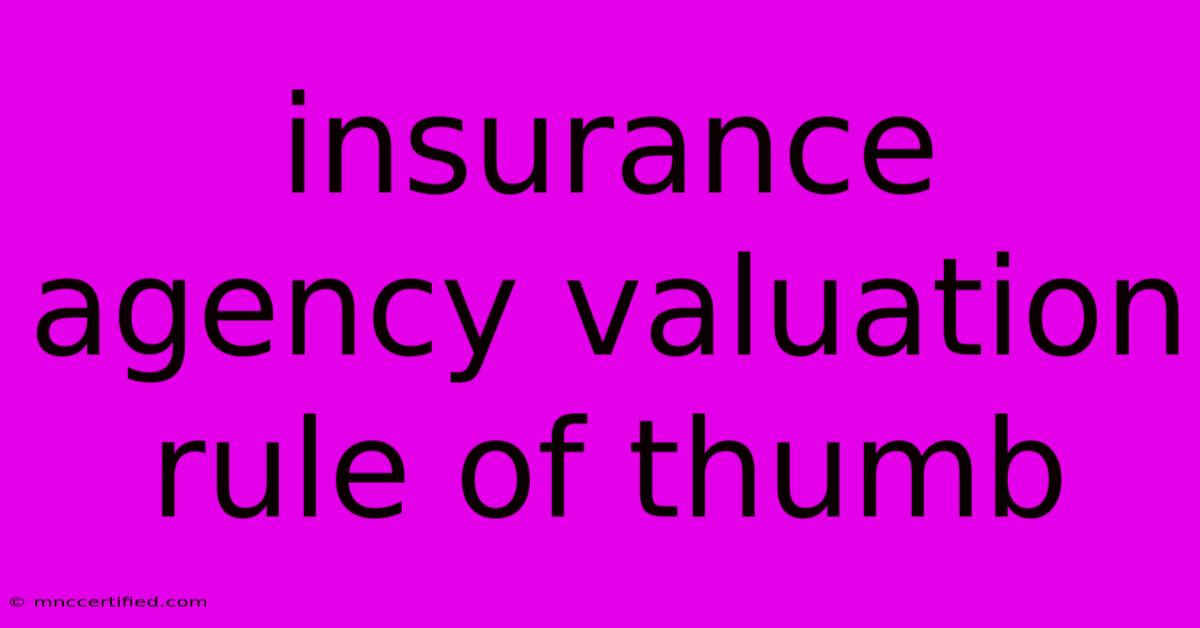Insurance Agency Valuation Rule Of Thumb

Table of Contents
Insurance Agency Valuation: A Guide to Rule of Thumbs and Beyond
Buying or selling an insurance agency is a major financial decision. Determining the right price requires more than just a gut feeling – it demands a structured approach. While a comprehensive valuation involves complex financial analysis, a solid starting point relies on rule of thumb valuations. These offer a quick and dirty method to gauge an agency's worth.
Understanding Rule of Thumb Valuations
Rule of thumb valuations are simple formulas that use key metrics like revenue, profit, and book value to estimate an agency's worth. They are not foolproof but provide a useful benchmark for initial discussions and negotiations.
Common Rule of Thumb Formulas:
- Revenue Multiple: Multiply the agency's annual revenue by a factor of 0.5 to 2.0. This is a broad range, influenced by factors like agency size, book of business, and growth potential.
- Profit Multiple: Multiply the agency's annual profit (often measured as EBITDA – Earnings Before Interest, Taxes, Depreciation, and Amortization) by a factor of 3.0 to 6.0. This method focuses on profitability, rewarding agencies with strong margins.
- Book Value Multiple: Multiply the agency's net book value (assets minus liabilities) by a factor of 1.0 to 2.0. This method is less common, as book value can be outdated and doesn't reflect market value.
Example:
Let's say an agency generates $1 million in annual revenue and has a profit (EBITDA) of $200,000.
- Revenue Multiple: Using a factor of 1.5, the valuation would be $1 million * 1.5 = $1.5 million.
- Profit Multiple: Using a factor of 4.0, the valuation would be $200,000 * 4.0 = $800,000.
The chosen multiple will vary based on several factors, including:
- Industry: Specific niches within insurance have different valuations.
- Market Conditions: A strong economy generally leads to higher multiples.
- Agency Size: Smaller agencies often command lower multiples due to higher risk.
- Book of Business Quality: Agencies with stable, high-value clients tend to be valued higher.
- Growth Potential: Agencies with strong future prospects attract higher multiples.
Limitations of Rule of Thumbs
While helpful for initial assessments, rule of thumb valuations have significant limitations:
- Oversimplification: They don't account for nuances like agency management, client retention, and regulatory environment.
- Lack of Individualization: They fail to consider specific agency strengths and weaknesses.
- Potential for Bias: They can be influenced by the perspective of the buyer or seller.
Beyond Rule of Thumbs: Comprehensive Valuation
For a precise and reliable valuation, consult with qualified professionals:
- Business Brokers: They specialize in insurance agency transactions and understand market trends.
- Certified Public Accountants (CPAs): They can conduct thorough financial analysis, examining income statements, balance sheets, and cash flow statements.
- Valuation Experts: These professionals have specialized knowledge in valuing intangible assets like goodwill and client relationships.
A comprehensive valuation involves:
- Detailed Financial Analysis: Scrutinizing financial statements and historical performance data.
- Market Research: Analyzing industry trends and competitor valuations.
- Cash Flow Projections: Forecasting future revenue and expenses.
- Discounted Cash Flow Analysis (DCF): Projecting future cash flows and discounting them to their present value.
- Asset Valuation: Assessing the value of tangible assets like equipment and inventory.
- Intangible Asset Valuation: Determining the value of goodwill, brand reputation, and client relationships.
Conclusion
While rule of thumb valuations offer a starting point for understanding the value of an insurance agency, a comprehensive valuation is crucial for informed decision-making. Investing in a professional assessment ensures a fair and accurate evaluation, minimizing risks and maximizing the return on your investment. By understanding the limitations of rule of thumb methods and seeking professional expertise, you can confidently navigate the complex landscape of insurance agency valuation.

Thank you for visiting our website wich cover about Insurance Agency Valuation Rule Of Thumb. We hope the information provided has been useful to you. Feel free to contact us if you have any questions or need further assistance. See you next time and dont miss to bookmark.
Featured Posts
-
An Insurance Contract May Be Unlawful If
Nov 08, 2024
-
Bo E Rate Cut What Does It Mean For Mortgages
Nov 08, 2024
-
Kidney Stone Surgery Cost With Insurance
Nov 08, 2024
-
Manchester United Vs Paok Live Europa League Match
Nov 08, 2024
-
Christian Counselors That Take Insurance
Nov 08, 2024